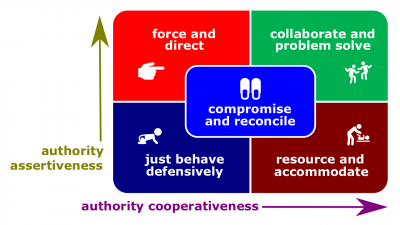Difference between revisions of "Conflict-resolution strategy"
(→Related coursework) |
(→Related lectures) |
||
| Line 9: | Line 9: | ||
==Related lectures== | ==Related lectures== | ||
| − | *[[ | + | *[[Relationship Management Quarter]]. |
[[Category: Septem Artes Administrativi]][[Category: Articles]] | [[Category: Septem Artes Administrativi]][[Category: Articles]] | ||
Latest revision as of 02:17, 6 January 2019
Conflict-resolution strategy (hereinafter, the Strategy) is a policy behind a conflict-resolution technique to be chosen in order to resolve the conflict.
Types
- Just behave defensively. The conflict-resolution strategy behind conflict-suppressing techniques that involve retreating from an actual or potential conflict situation; postponing active involvement to be better prepared or to wait the conflict to be resolved by others and/or to fade with time.
- Resource and accommodate. The conflict-resolution strategy behind conflict-solving techniques that involve (a) adding resources to solve the conflict and/or (b) conceding one's position to the needs of others to maintain harmony and relationships.
- Compromise and reconcile. The conflict-resolution strategy behind conflict-solving techniques that involve searching for solutions that bring some degree of satisfaction to all parties in order to temporarily or partially resolve the conflict.
- Force and direct. The conflict-resolution strategy behind conflict-suppressing techniques that involve pushing one's viewpoint at the expense of others; offering only win-lose solutions, usually enforced through a power position to resolve an emergency.
- Collaborate and problem solve. The conflict-resolution strategy behind conflict-solving techniques that involve incorporating multiple viewpoints and insights from differing perspectives; requires a cooperative attitude and open dialogue that typically leads to consensus and commitment.
